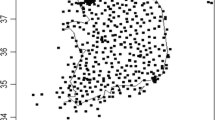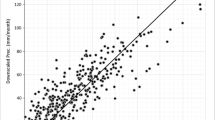Abstract
Precipitation forecasting plays a key role in natural resource management, agriculture management, and water requirement provision. Hence, dendroclimatology methods and artificial neural network (ANN) are used to estimate precipitation values in the past times. Moreover, a geographic information system (GIS) can be applied as a tool to demonstrate the spatial variation of precipitation. In this study, earlywood vessel features and tree-rings of Siberian elm species were used to simulate precipitation. The vessel features, the tree-ring extent, and the secondary data of climatologic station from the different sites were studied. At first, cross-dating and standardization of the tree-rings and vessels were performed. Then, time series analysis was done. In the next step, the relations between vessel chronologies and tree-rings with the precipitation were defined. The input parameters were selected tree-ring width and vessel features for the modeling, whereas precipitation of the growing season was selected as the output. The model or network was trained and verified by taking a case study of Fomanat plain (northern part of Iran). The results showed that the combinatory usage of vessel features and tree-rings extent in precipitation simulating can increase simulation capability. Further, different isohyets were generated using the simulated precipitation values, an interpolation technique in a GIS system. The results showed that the highest precipitation and the lowest precipitation have occurred in 1926 and 1986 during the last century.








Similar content being viewed by others
References
Abhishek K, Singh MP, Ghosh S, Anand A (2012) Weather forecasting model using artificial neural network. Procedia Technol 4:311–318
Anctil F, Rat A (2005) Evaluation of neural networks streamflow forecasting on 47 watersheds. J Hydrol Eng 10:85–88
Blasing TJ, Stahle DW, Duvick DN (1988) Tree-ring based reconstruction of annual precipitation in the south-central United States from 1750 to 1980. Water Resour Res 24:163–171
Bradley RS, Jones PD (1992) Climate since AD. 1500. Routledge, London, p 679
Briffa K, Jones PD (1990) Basic chronology statistics and assessment. In: Cook ER, Kairiukstis LA (eds) Methods of dendrochronology: applications in the environmental sciences. International Institute for Applied Systems Analysis. Kluwer Academic Publishers, Boston, pp 137–152
Briffa KR, Jones PD, Schweingruber FH (1988) Summer temperature patterns over Europe: a reconstruction from 1750 ad based on maximum latewood density indices of conifers. Quat Res 30:36–52
Campello M, Graham JR, Harvey CR (2010) The real effects of financial constraints: evidence from a financial crisis. J Financ Econ 97:470–487
Conkey LE (1979) Response of tree-ring density to climate in Maine, U.S.A. Tree-Ring Bull 39:29–38
Cook ER, Peters K (1981) The smoothing spline: a new approach to standardizing forest interior tree-ring width series for dendroclimatic studies. Tree-Ring Bull 41:45–55
Davis EL, Laroque CP, Van Rees K (2012) Evaluating the suitability of nine shelterbelt species for dendrochronological purposes in the Canadian prairies. Agrofor Syst 87:713–727
Fonti P, Garcia Gonzalez I (2004) Suitability of chestnut earlywood vessel chronologies for ecological studies. New Phytol 163:77–86
Fonti P, Garcia Gonzalez I (2008) Earlywood vessel size of oak as a potential proxy for spring precipitation in mesic sites. J Biogeogr 35:2249–2257
Fritts HC (1976) Tree rings and climate. Academic Press, London, p 567
Fritts HC (2001) Tree rings and climate. Academic Press, New York, pp 303–311
Garcia Gonzalez I, Eckstein D (2003) Climatic signal of earlywood vessels of oak on a maritime site. Tree Physiol 23:497–504
Gholami V, Chau KW, Fadaee F, Torkaman J, Ghaffari A (2015) Modeling of groundwater level fluctuations using dendrochronology in alluvial aquifers. J Hydrol 529:1060–1069
Gholami V, Ahmadi Jolandan M, Torkaman J (2017a) Evaluation of climate change in northern Iran during the last four centuries by using dendroclimatology. Nat Hazards 85(3):1835–1850
Gholami V, Torkaman J, Khaleghi MR (2017b) Dendrohydrogeology in paleohydrogeologic studies. Adv Water Resour 110:19–28
Gray ST, Graumlich LJ, Betancourt JL (2007) Annual precipitation in the Yellowstone National Park region since AD 1173. Quat Res 68:18–27
Grissino-Mayer (1993) An updated list of species used in tree-ring research. Tree-Ring Bull 53:17–43
Hacke UG, Sperry JS (2001) Functional and ecological xylem anatomy. Perspect Plant Ecol Evol Syst 4:97–115
Hung NQ, Babel MS, Weesakul S, Tripathi NK (2009) An artificial neural network model for rainfall forecasting in Bangkok, Thailand. Hydrol Earth Syst Sci 13:1413–1425
Isik S, Kalin L, Schoonover J, Srivastava P, Lockaby BG (2013) Modeling effects of changing land use/cover on daily stream flow: an artificial neural network and curve number based hybrid approach. J Hydrol 485:103–112
Kames S, Tardif JC, Bergeron Y (2016) Continuous earlywood vessels chronologies in floodplain ring-porous species can improve dendrohydrological reconstructions of spring high flows and flood levels. J Hydrol 534:377–389
Khaleghi MR (2018) Application of dendroclimatology in evaluation of climatic changes. J For Sci 64(3):139–147
Kleppe JA (2005) A study of ancient trees rooted 36.5M (120’) below the surface level of Fallen Leaf Lake. Nev Water Resour J Lake Tahoe Ed 2:29–40
Leblanc D, Terrella M (2001) Dendroclimatic analyses using Thornthwaite Mather type evapotranspiration models: a bridge between dendroecology and forest simulation models. Tree-Ring Res 57:55–66
Linares JC, Tiscar PA (2010) Climate change impacts and vulnerability of the southern populations of Pinus nigra ssp. salzmannii. Tree Physiol 30:795–806
Maqsood I, Khan MR, Abraham A (2004) An ensemble of neural networks for weather forecasting. Neural Comput & Applic 13:112–122
Meko DM, Therrell MD, Baisan CH, Hughes MK (2001) Sacramento River flow reconstructed to AD 869 from tree rings. J Am Water Res Assoc 37:1029–1040
Naurzbaev MM, Sidorova OV (2004) Low and high frequencies in long-term tree-ring chronologies from northern Eurasia. Abst, All-Russian conference, Krasnoyarsk pp 466–467
Nikzad Tehrani E, Sahour H, Booij MJ (2018) Trend analysis of hydro-climatic variables in the north of Iran. Theor Appl Climatol. https://doi.org/10.1007/s00704-018-2470-0
Paredes-Villanueva K, López L, Brookhouse M, Navarro Cerrillo RM (2015) Rainfall and temperature variability in Bolivia derived from the tree-ring width of Amburana cearensis (Fr. Allem.) AC Smith. Dendrochronologia 35:80–86
Piutti E, Cescatti A (1997) A quantitative analysis of the interactions between climatic response and intraspecific competition in European beech. Can J For Res 27:277–284
Pourtahmasi K, Bräuning A, Poursartip L, Burchardt I (2012) Growth–climate responses of oak and juniper trees in different exposures of the Alborz Mountains, northern Iran. Trace 10:49–53
Robertson EO, Jozsa LA, Spittlehouse DL (1990) Estimating douglasfir wood production from soil and climate data. Can J For Res 20:357–364
Sahour H, Mokhtari A, Ghahfarokh SS (2016) Rainfall-runoff modeling using remotely sensed data and hydrologic modeling system. Ecol Envir Conserv 22(4):1735–1745
Sass U, Eckstein D (1994) Preparation of large thin sections and surfaces of wood for automatic image analysis. Holzforschung 48:117–118
Sperry JS, Hacke UG, Pittermann J (2006) Size and function in conifer tracheids and angiosperm vessels. Am J Bot 93:1490–1500
Tardif JC, Conciatori F (2006) Influence of climate on tree rings and vessel features in red oak and white oak growing near their northern distribution limit, southwestern Quebec, Canada. Can J For Res 36:2317–2330
Voelker SL (2011) Age-dependent changes in environmental influences on tree growth and their implications for forest responses to climate change. Size- and age-related changes in tree structure and function. In: Meinzer FC, Lachenbruch B, Dawson TE (eds) Tree physiol, vol 4, pp 455–479
Watson E, Luckman H (2005) An exploration of the controls of n pre-instrumental stream flow using multiple tree-ring proxies. Dendrochronology 22:225–234
Wigley TML, Briffa KR, Jones PD (1984) On the average value of correlated time series, with applications in dendroclimatology and hydrometeorology. J Clim Appl Meteorol 23:201–213
Woodhouse CA (2000) Extending hydrologic records with tree rings. Water Resour Impact 2:25–27
Woodhouse CA, Meko DM, MacDonald GM, Stahle DW, Cooke ER (2010) A 1200-year perspective of 21st century drought in southwestern North America. Proc Natl Acad Sci U S A 107:21283–21288
Acknowledgments
We should thank the Regional Water Company of Guilan (RWCG) for presenting the secondary precipitation data and for preprocessing the climatic data.
Author information
Authors and Affiliations
Corresponding author
Additional information
Publisher’s Note
Springer Nature remains neutral with regard to jurisdictional claims in published maps and institutional affiliations.
Rights and permissions
About this article
Cite this article
Gholami, V., Torkaman, J. & Dalir, P. Simulation of precipitation time series using tree-rings, earlywood vessel features, and artificial neural network. Theor Appl Climatol 137, 1939–1948 (2019). https://doi.org/10.1007/s00704-018-2702-3
Received:
Accepted:
Published:
Issue Date:
DOI: https://doi.org/10.1007/s00704-018-2702-3




